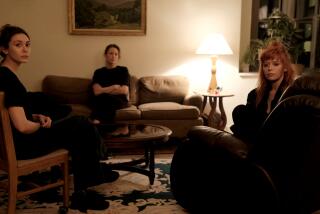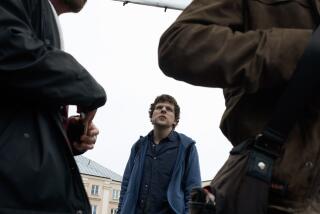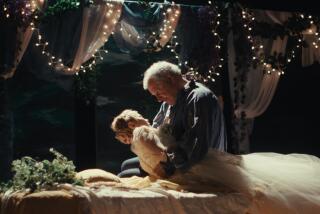Actors’ dark path to enlightenment
The death of a child is every parent’s worst nightmare. So when Nicole Kidman took on the role of a mother mourning the loss of her 4-year-old son in “Rabbit Hole” just a year after giving birth to a daughter in real life, she knew she was venturing into emotionally treacherous territory.
“I had a conversation with my husband, because I needed him to understand that I’ve got to go exist in a limbo place for a while,” the actress said. “It’s a strange balancing act.”
Yet during production, Kidman found her equilibrium faltering, unable to contain to the set the experience of her character’s grief.
“This role very much played out in my dreams,” said Kidman, who went on to be nominated for an Academy Award for the performance. “That’s how I knew I was deeply disturbed, because I’d have unbearable nightmares where I’d wake up absolutely sobbing. I think I’m handling it, and it comes out that way.”
Among this year’s Oscar contenders, Kidman was not alone in suffering for her art. In “Biutiful,” Javier Bardem plays a single father with terminal cancer who is beset by a series of other tragedies. Natalie Portman had to lose her mind over a period of a few weeks for “Black Swan.”
One of the peculiar traits of actors is that they seek out experiences the rest of us fear — death, loss, insanity — as part of their jobs. Probing life’s darkest places can lead to some tangible rewards, like Oscar nominations and big paydays. But actors and the people who guide them say there are also psychic risks — and some emotional benefits — to enduring humanity’s greatest traumas in front of camera.
“Actors are drawn toward exciting, forbidden places where extreme things happen,” said Robert Landy, author of “The Couch and the Stage” and professor of educational theater and applied psychology at New York University. “Acting is a way to go to a place that is both very dangerous and also very contained because it’s a fiction. You can enter a fiction and you can leave it.”
Somewhere around the 50th time Bardem died of cancer during production of “Biutiful,” his director began to worry whether he was, in fact, leaving the fiction on set.
“I can be unbearable sometimes asking for so many takes,” Alejandro González Iñárritu said. “To survive that as an actor with that kind of subject matter is not easy. Toward the end, he was in such a delicate state, getting the truth of every single scene.”
Bardem said he felt emotionally wrung out by filming “Biutiful,” and doesn’t recognize himself when he watches the movie.
“A lot of times I was asking myself, is it worth it?” he said. “There’s a force of nature that pulls you in and you go, no, no, no. And once you’re there, you disappear.”
Iñárritu added: “This film began to get into us like the humidity. We got soaked.”
To play Nina, a young ballerina preparing for “Swan Lake,” Portman spent five hours a day training in dance and lost 20 pounds from her already slender frame. “Black Swan” producer Scott Franklin said her physical metamorphosis helped the actress meet the psychological challenge of the performance.
“The physicality of the role drove the emotion,” he said. “Natalie spent a year transforming herself. The intensity of it, the weight she lost, all the time she spent with these ballerinas — it all helped her mentally prepare.”
Portman has said her degree in psychology from Harvard University proved useful in shaping the character as well. “The rituals of ballet really correspond to O.C.D. [obsessive compulsive disorder], and anorexia is a form of O.C.D. as well,” Portman said. “And the idea of how you view yourself and if you’re used to seeing yourself through other people’s eyes, a lot that was helpful.”
For some actors, even excellent ones, their work really is just an elaborate game of make-believe. Spencer Tracy famously described his job as “come to work on time, know your lines and don’t bump into the other actors.” But many others rely on some form of Method acting, using deeply felt emotional triggers to deliver a lifelike performance.
“Some of them have a wonderful ability to open up that wound,” said John Kirby, an acting coach who has worked with Jeff Bridges, Cameron Diaz and James Caviezel. “They choose something personal to use in a performance, and it takes them where they need to go to support the fiction.”
Whether that experience is enlightening or debilitating varies from set to set and actor to actor. The Screen Actors Guild has rules about how many hours a performer can work, and how often they must be fed, but there’s no such thing as stunt pay for breaking your heart take after take.
“A lot depends on the skill and competence and sensitivity of a director,” Landy said. “Some directors are trained in the potential dangers of actors going to dark places. Others might not give a damn.”
When he began to make “Black Swan” with Portman, director Darren Aronofsky had just covered similarly fraught terrain with another actor, Mickey Rourke in “The Wrestler.”
“Actors know when they’re working with a director who respects them as human beings,” said Franklin, who also produced “The Wrestler.” “Darren makes sure that nobody loses sight of where we are. Actors trust him and rightfully so. He keeps their trust by staying honest with them. He doesn’t play any psychological games. And he’s very clear in his communication.”
Properly supported, actors can visit shadowy places and emerge not only intact, but evolved, according to Kirby. “People love acting because it gives them an opportunity to explore many parts of themselves,” Kirby said. “Sometimes it gives them an opportunity to work through past relationships, or some of their scars from growing up. It becomes very cathartic.”
Kidman said at times she has questioned whether the emotional toll is worth it. “I don’t particularly enjoy” dark performances, she said, “but I know now that I have to act. I tried to convince myself that I don’t need to do this anymore. Because part of it is like, well why would I keep wanting to do this to myself?”
But ultimately, she said, the nightmares she experienced during the making of “Rabbit Hole” brought some personal reward. “Some people have said, ‘You must be a masochist,’” she said. “No, not at all, but I’m committed to understanding the human condition. I want to understand that. It makes me a kinder, more compassionate person when I can live and try to absorb these things.”
For any actor approaching an emotionally demanding role, what is crucial is a level of self-awareness, according to Kirby. “A role becomes very dangerous when the subject matter that they’re dealing with speaks so loudly to their personal world, and it might be something that they haven’t fully come to terms with yet and it might set them off,” Kirby said.
Sean Penn has compared the “soulful gravitas” in Bardem’s performance in “Biutiful” to Marlon Brando’s work in “Last Tango in Paris.” In that 1972 film, the Method actor played a man mourning his wife’s suicide with powerful expressions of rage and grief.
After living through dying of cancer in “Biutiful,” Bardem quickly went on to film a decidedly lighter role as the hunk who sweeps Julia Roberts off her feet in “Eat Pray Love” and then shot another as a priest in Terrence Malick’s “Tree of Life.” “The reward of [acting] is that when you come back, you know more about yourself,” Bardem said. “That’s the great gift of being an actor, being able to see the world with different eyes.”
After “Last Tango in Paris,” Brando, who had always harbored an ambivalence toward acting, took a different path. He didn’t appear in another film until 1976. “I will never make a film like this one again,” Brando told “Last Tango” director Bernardo Bertolucci. “I don’t like being an actor in the best of times, but it’s never bothered me this bad.”
“Last Tango” was Brando’s last, great leading role. The actor’s later years, during which he worked sporadically, were marked by a troubled family life and obesity. “When he stopped acting, Brando truly fell apart,” Landy said. “For some artists, acting isn’t the dangerous place to go. Life is the dangerous place to go.”
Times staff writer Amy Kaufman contributed to this report.
More to Read
The biggest entertainment stories
Get our big stories about Hollywood, film, television, music, arts, culture and more right in your inbox as soon as they publish.
You may occasionally receive promotional content from the Los Angeles Times.











